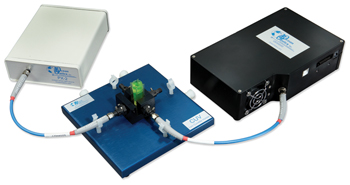
QE65000型科研级光谱仪结合了探测器、光学平台和电子器件的功能,为用户提供灵敏的系统,满足在低亮度情况下的应用,例如荧光、DNA测序、天文学和拉曼光谱等。QE65000型科研级光谱仪的量子效率可达90%,并具有很高的信噪比和快速的信号处理能力。
量子效率高达90%
QE65000型科研级光谱仪是我们研发的产品中最灵敏的光谱仪,其量子效率(其定义是光子转变成光电子的效率)可以达到90%。
QE65000型科研级别光谱仪含有一个对紫外线感应能力超强的日本滨松出品的薄型背照式(Back-thinned)探测器。它的二维像素阵列(水平1044像素×垂直64像素)可以响应波长范围为200~1100nm的光信号。特定的光谱范围和解析度是由用户的光栅和入射光狭缝的选择来决定的。探测器的像素列在数据输出前就累加的,这样可以使采集数据的噪声最小化。
用所包含的热电制冷器,检测器可以被冷却到零下20℃,以减少暗噪声。噪声和暗信号的减少可以使光谱仪的积分时间达到15分钟,并因此大大提高低亮度级别测试时的检测极限。
光谱仪的低噪声检测器与16位的模拟/数字转换器使得动态范围达到25000:1,信噪比大于1000:1。
更高的系统灵敏度
由于二维检测器使光谱仪能很好地利用入射光狭缝的高度,QE65000型科研级光谱仪的灵敏度得到了一定的提高。在我们生产的其它光谱仪中,光进入光具座是通过入射光狭缝的宽度来调节的;狭缝的高度是没有影响的,因为线性检测器不能有效地收集狭缝的整个高度的光。而使用QE65000型科研级光谱仪的二维检测器,我们就可以更好地利用来自高度方向的额外的光信号。
优异的紫外光响应能力
QE65000型科研级别光谱仪的薄型背照式(Back-thinned)探测器对紫外线具有优异的响应能力,并且不需要外加涂层来提高其性能。
满足低亮度级别应用的条件
QE65000型科研级光谱仪是一个适合在低亮度应用的极好选择,包括在荧光、拉曼光谱、DNA测序、天文学和薄膜反射等各个方面。用户可以根据需要,将光谱仪的积分时间(类似于照相机的快门速度)设置成8ms~15min内的数值,而不会产生光学失真。下面是一个利用QE65000型科研级光谱仪、CUV-ALL 四方式比色皿架 、和PX-2型氙光源进行荧光分析的实例。特别说明:为了对PX-2型氙光源进行外部触发操作,还需要HR4-BREAKOUT外接盒。

用户可编程输入/输出端口
QE65000型科研级光谱仪携带的模块含有10个可由用户编程的数字输入/输出端口,以便于和其它设备连接;并含有一个可以触发其它设备的脉冲发生器。在光谱仪的积分时间段内,用户可以使用这些输入/输出端口来点亮光源、开始或停止某项进程,或者发送信息和提示。光谱仪的操作参数可以通过软件来控制。实际上,每一个光谱仪特有的波长校准系数也是设置在光谱仪的记忆芯片中的。
SPECIFICATIONS
Physical | |||
| Dimensions: | 182 mm x 110 mm x 47 mm | ||
| Weight: | 1.18 kg (without power supply) | ||
| Detector | |||
Detector: | Hamamatsu S7031-1006 | ||
| Detector range: | 200-1100 nm | ||
Pixels: | 1024 x 58 (1044 x 64 total pixels) | ||
Pixel size: | 24.576 um2 | ||
Pixel well depth: | 1000 Ke- | ||
| Sensitivity: | ~0.065 counts / e- | ||
| Quantum efficiency: | 90% peak; 65% at 250 nm | ||
| Optical Bench | |||
| Design: | f/4, Symmetrical crossed Czerny-Turner | ||
| Focal length: | 101.6 mm input and output | ||
| Entrance aperture: | 5, 10, 25, 50, 100 or 200 um wide slits or fiber (no slit) | ||
| Grating options: | 14 different grating options, UV through Shortwave NIR | ||
| HC1-QE grating option: | provides UV-Shortwave NIR coverage | ||
| Detector collection lens option: | None | ||
| OFLV filter options: | OFLV-QE (200-950 nm); OFLV-QE-250 (250-1000 nm); OFLV-QE-300 (300-1050 nm); OFLV-QE-350 (350-1100 nm); OFLV-QE-400 (400-1150 nm) | ||
| Other bench filter options: | Longpass OF-1 filters | ||
| Collimating and focusing mirrors: | Standard only | ||
| UV enhanced window: | No | ||
| Fiber optic connector: | SMA 905 to 0.22 numerical aperture single-strand optical fiber | ||
| Spectroscopic | |||
| Wavelength range: | Grating dependent | ||
| Optical resolution: | ~0.14-7.7 nm FWHM | ||
| Signal-to-noise ratio: | 1000:1 (at full signal) | ||
| A/D resolution: | 16 bit | ||
| Dark noise: | 3 RMS counts | ||
| Dynamic range: | 7.5 x 109 (system), 25000:1 for a single acquisition | ||
| Integration time: | 8 ms to 15 minutes | ||
| Stray light: | <0.08% at 600 nm; 0.4% at 435 nm | ||
| Corrected linearity: | >99.8% | ||
| Electronics | |||
| Power consumption: | 500 mA @ 5 VDC (no TE cooling); 3.5 A @ 5 VDC (with TE cooling) | ||
| Data transfer speed: | Full scans to memory every 7 ms with USB 2.0 port, 18 ms with USB1.1 port, 300 ms with serial port | ||
| Inputs/Outputs: | 10 onboard digital user-programmable GPIOs (general purpose inputs/outputs) | ||
| Analog channels: | No | ||
| Auto nulling: | Yes | ||
| Breakout box compatibility: | Yes, HR4-BREAKOUT | ||
| Trigger modes: | 4 modes | ||
| Strobe functions: | No | ||
| Gated delay feature: | Yes | ||
| Connector: | 30-pin connector | ||
| Power-up time: | <5 seconds | ||
Dark current: | 4000 e-/pixel/sec @ 25 Celsius; 200 e-/pixel/sec @ 0 Celsius | ||
| Computer | |||
| Operating systems: | Windows 98/Me/2000/XP, Mac OS X and Linux with USB port; Any 32-bit Windows OS with serial port | ||
| Computer interfaces: | USB 2.0 @ 480 Mbps; RS-232 (2-wire) @ 115.2 K baud | ||
| Peripheral interfaces: | SPI (3-wire); I2C inter-integrated circuit | ||
| Temperature and Thermoelectric (TE) Cooling | |||
| Temperature limits: | 0 Celsius to 50.0 Celsius; no condensation | ||
| Set point: | Software controlled; lowest set point is 40 Celsius below ambient | ||
| Stability | +/-0.1 Celsius of set temperature in <2 minutes | ||